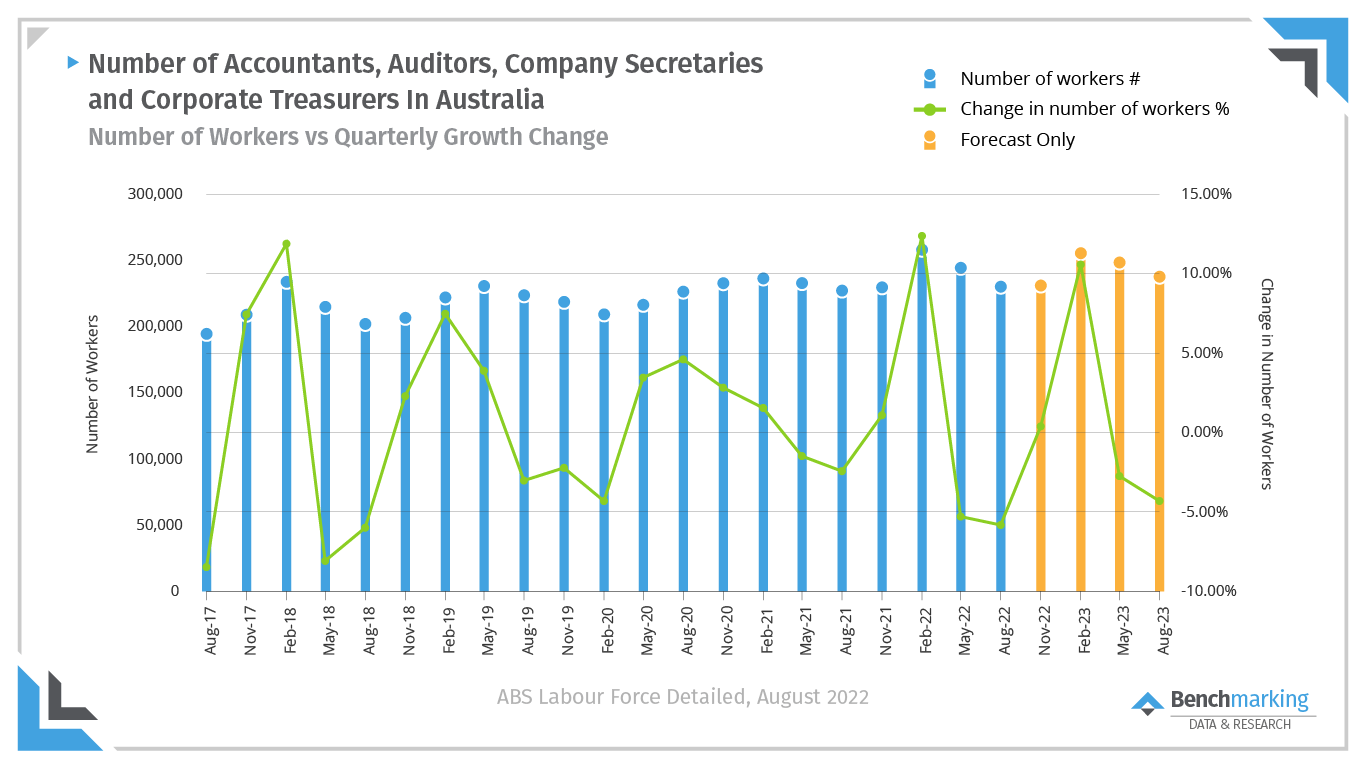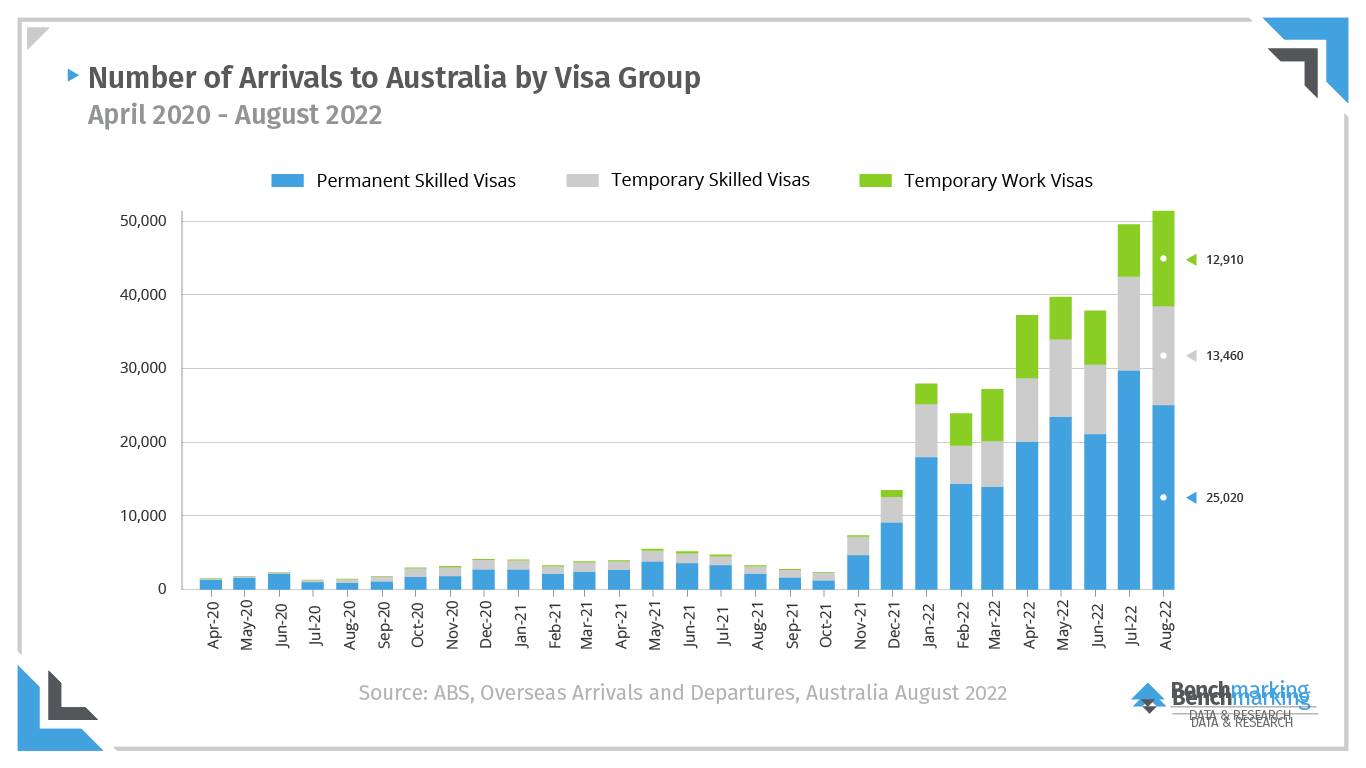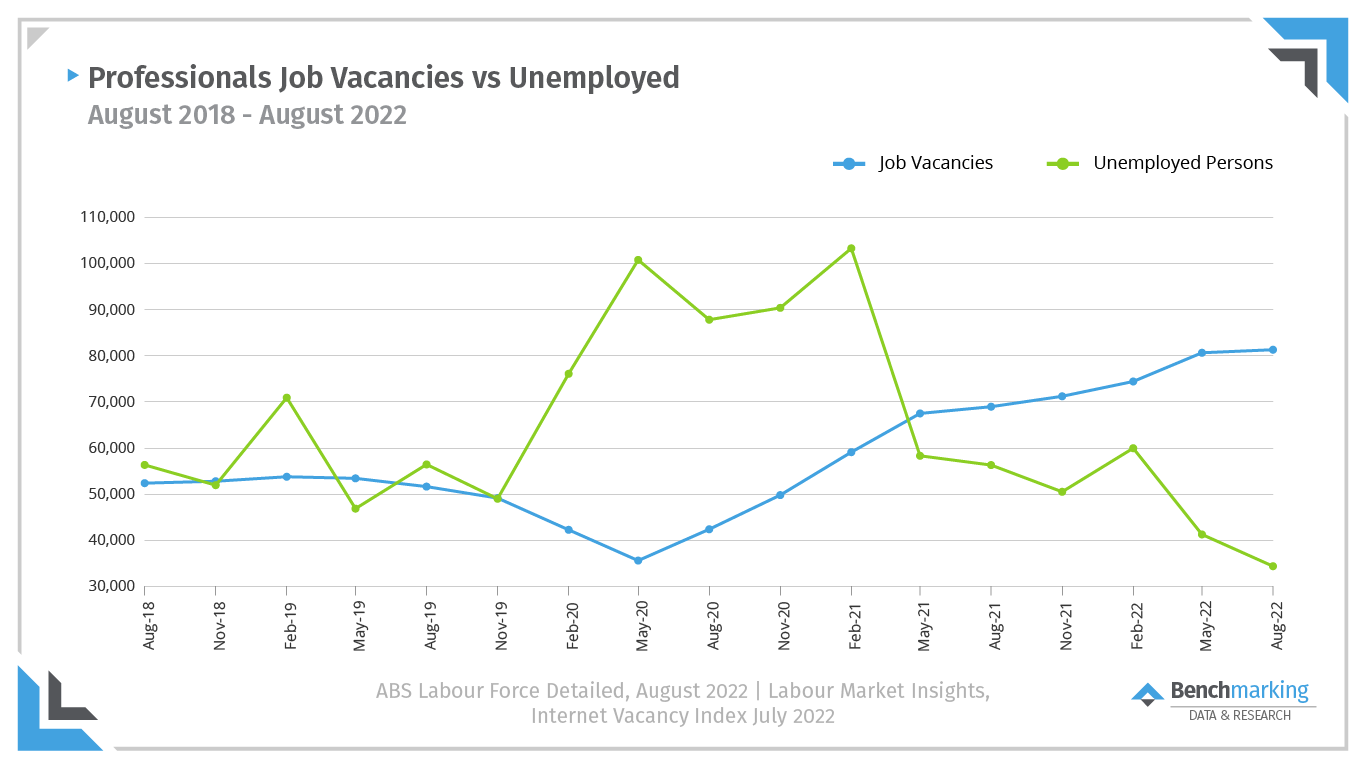As CPA Australia chief executive Andrew Hunter said recently: “Before the pandemic, skills shortages in the accounting profession were already an issue. The current situation is now critical. Latest data shows there’s a huge, unmet demand, with jobs ads for accountants increasing by 34 per cent in the year to June 2022.”
However, the data is not all bad. The most recent statistics revealed five key insights that will impact recruitment and retention for accounting firms.
The positives
- The number of accountants begins to normalise
Most years the number of accountants, auditors, company secretaries and corporate treasurers spikes in February. Undoubtedly, this is to deal with tax lodgement deadlines for Australian businesses in May.
February 2022 saw a record number of workers, up 23.3 per cent compared to February 2020. This was followed by a routine decline in May 2022 and August 2022. This cycle is typical for the industry.
Prior to this, numbers remained relatively stalled from May 2020 to November 2021.
As the accountant cycle appears to be normalising, firms can use these insights to build recruitment strategies.

By knowing this trend, we can also forecast the number of accountants needed for the next 12 months (see graph above).
As there are consistently fewer accountants working in August, it could be a prime time to recruit for the busier months ahead. Theoretically, the unemployed pool will be larger, and there will be less competition.
Firms can also look to maximise employee output during quieter months via business advisory services. This both leverages the increased resources and generates sustainable revenue all year round. The latest NAB Key Insights Into the Australian Accounting Industry Report showed the most sought-after services SMEs wanted from their accountants were business strategy and advice on financial future and growth opportunities.
- Return of skilled migrants
The second positive story for the industry is the return of skilled migrants. July and August saw a large uptick in skilled migration and temporary work arrivals.

These numbers will consistently rise due to policies announced at the Jobs and Skills Summit to strengthen the migration system.
Over the next six months, the industry should benefit from both the return of skilled migrants and the additional skilled migration cap announced at the Jobs and Skills Summit.
However, firms should be aware the increase of 35,000 skilled migrants will only provide some relief for the longer-term shortage. Initial forecasts estimate the increase will bring an additional 4,850 accountants and auditors to Australia over five years; well short of the National Skills Commission’s five-year employment projection of 25,600.
The challenges
- The professional skill shortage
One of the greatest challenges is the lack of skilled professionals compared to the demand. In August 2022 (an estimate), this gap widened. There are now 2.4 unemployed professionals for every professional job advertised.

The professional shortage poses a unique challenge for the accounting industry: accountants can fill other professional services roles such as management consultants and advisers, but the reverse is not always true.
There is also an increased skills grab from the big consulting firms in Australia with Deloitte, PwC, EY, KPMG and Accenture currently advertising for more than 4,000 positions between them. While they are not solely professional services roles, the sheer number of employees requested increases the overall demand for skilled workers.
Unfortunately, smaller firms often feel the impact of shortages more than their larger counterpart with deeper pockets.
Opening migration will greatly benefit larger firms that have systems in place to leverage skilled migrants; thus, there should be a larger pool of talent available for smaller firms to access.
- No job vacancy slowdown
Traditionally, after June each year the accounting industry sees a decrease in advertised job vacancies. For the second half of the year, vacancies remain relatively stable until they peak again the following February. This is reflected in the job numbers above where February also shows the highest number of workers.

From April 2020 to June 2021, the data highly fluctuates, reflecting the impact of the pandemic. After this, the trend appears to revert to pre-pandemic numbers.
However, from the February 2022 peak, job vacancy numbers for accountants have not dropped as much as would be expected. June 2022 was the only month to experience a decrease in growth this year.
This shows jobs are simply not being filled.
On a positive note, job vacancies for auditors, company secretaries and corporate treasurers have reverted to previous trends showing demand may be starting to decrease.
Over the next six months, we would expect the number of job vacancies to decrease in line with the increase in skilled migrants and then peak again in February 2023.
Has Australia hit the Great Resignation?
There has been much debate regarding the Great Resignation. In essence, Australia has not yet felt the wave of resignations experienced by its international counterparts — primarily the US.
Yet in the past 12 months, the number of people leaving their jobs voluntarily has dramatically increased. From 2019–22, voluntary resignations increase by 41.9 per cent (compared to 8.3 per cent from 2016–19.)
People leaving their job for a better job or a change has increased by 72.8 per cent in the past three years. To put this in perspective, the change in “people leaving their jobs for a better job” from 2016–19 was only 3.6 per cent.

Additionally, retirement is at record highs and involuntary redundancies have reverted to pre-COVID numbers.
With record numbers of Australians resigning, this poses both opportunities and challenges for accounting firms. “Better job” is recorded as the perception of a better job, not necessarily a pay rise or promotion. Thus managers/owners can put in place a two-pronged strategy. First, they must ensure current employees are satisfied and second, they can seek to make their firms more appealing to potential job jumpers.
The next six months
The expectant low recruitment period coupled with the return of skilled migrants should ease the accountant shortage somewhat in the immediate term. However, as February 2023 approaches, it is likely the industry will experience a mass supply shortage once again.
While the long-term solutions to address the shortage are more complex, firms can look to schedule their recruitment for lower seasons to leverage a larger pool. It may not solve the overall issue, but in the short term, it will enable smaller firms to better compete for much-needed talent.
Julia Thomson is head of data analytics and content at the Benchmarking Group.

 Login
Login











